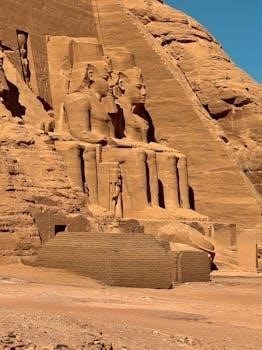Fingerprints of the Gods⁚ An Overview
Fingerprints of the Gods‚ a 1995 book by Graham Hancock‚ presents a revolutionary idea about human history․ It suggests that an advanced civilization existed long before our accepted timelines․ Hancock uses varied tools‚ including archaeo-astronomy and geological evidence‚ to support his claims․ This book challenges conventional views․
The Central Thesis of the Book

The core argument of Fingerprints of the Gods revolves around the notion that a sophisticated civilization‚ far older than any recognized by mainstream archaeology‚ once flourished on Earth․ This lost civilization‚ according to Hancock‚ possessed advanced knowledge in fields such as astronomy‚ mathematics‚ and architecture‚ which they then disseminated to subsequent cultures․ He proposes that this civilization was either destroyed or drastically reduced by a cataclysmic event‚ perhaps involving a pole shift or ice age‚ leaving only traces of their existence in myths‚ legends‚ and the design of ancient monuments around the world․ The book challenges the traditional linear progression of human history‚ suggesting a cyclical model where periods of advanced civilization are followed by periods of decline and a subsequent resurgence․ Hancock suggests that this lost civilization’s knowledge was encoded into these myths and monuments‚ waiting to be rediscovered by a more advanced civilization‚ leading to a reinterpretation of the story of human kind․ He utilizes evidence from diverse fields such as archaeo-astronomy‚ geology‚ and comparative mythology to make his case‚ presenting a compelling alternative to the accepted narrative of human prehistory․ This lost civilization‚ he argues‚ is the source of many of the similarities in ancient cultures around the world․
Graham Hancock’s Background and Approach
Graham Hancock is a British writer and journalist‚ not an academic archaeologist‚ which is crucial to understanding his approach in Fingerprints of the Gods․ His background in journalism lends itself to an investigative style‚ where he seeks to uncover evidence that challenges the accepted narratives․ He is known for his willingness to explore unconventional ideas and to question established authority․ Hancock’s approach is multidisciplinary‚ drawing from fields such as archaeo-astronomy‚ geology‚ mythology‚ and computer analysis of ancient myths‚ and synthesizes them to create a new historical narrative․ He often focuses on anomalies and unexplained phenomena in the archaeological record‚ using them as starting points for his investigations․ He travels extensively‚ visiting ancient sites worldwide‚ to gather firsthand evidence and present his observations․ Hancock is not afraid to make bold claims and is not constrained by academic conventions․ He presents his arguments in a narrative style‚ aiming to engage a wide audience‚ often highlighting the lack of mainstream explanations for certain historical questions․ His approach is very different from mainstream archaeologists‚ who focus on detailed fieldwork and data analysis․ His work is often referred to as pseudoarcheology․

Key Concepts and Theories Presented
The book proposes that an advanced civilization predates known history․ This civilization‚ according to Hancock‚ possessed advanced knowledge in various fields․ He uses evidence from diverse sources to support the theory‚ including mythology and geological findings․ The book challenges conventional views․
Advanced Ancient Civilization
Hancock’s central argument revolves around the existence of a sophisticated‚ technologically advanced civilization that flourished during the last Ice Age․ This civilization‚ he posits‚ was far more developed than what is currently acknowledged by mainstream archaeology․ According to his theory‚ this advanced society possessed knowledge of complex mathematics‚ astronomy‚ and engineering․ They were capable of constructing monumental structures and sophisticated maps․ He suggests this civilization’s culture and knowledge are reflected in myths and legends around the globe․
Hancock presents evidence like the Piri Reis map and ancient sites with advanced astronomical alignments to imply the existence of this civilization․ He argues that this civilization was responsible for transferring knowledge to various cultures after a cataclysmic event that destroyed it‚ which is why common themes and technologies exist across disparate cultures․ The book suggests the survivors carried the legacy of this advanced society to different parts of the world․ This lost civilization‚ Hancock argues‚ left a profound mark on human development and history․ He claims its influence can be seen in ancient monuments‚ myths‚ and the shared cultural heritage of mankind․ The book posits this advanced civilization is not merely a forgotten society but a key to understanding the true origins of human civilization․
Archaeo-astronomy and Geological Evidence
Hancock utilizes archaeo-astronomy‚ the study of how ancient people understood celestial phenomena‚ to bolster his claims․ He points to the precise alignment of ancient structures with astronomical events‚ like solstices and equinoxes‚ as indicators of advanced knowledge․ These structures‚ he argues‚ are not random but carefully planned to reflect celestial events․ This suggests a high level of astronomical understanding that conventional history attributes to much later periods․ The book also presents geological evidence for cataclysmic events․ Hancock discusses the theory of Earth Crust Displacement‚ suggesting a sudden shift in the earth’s surface․ This would have caused massive floods and climate change‚ impacting the advanced civilization․
He cites evidence from areas like Antarctica‚ suggesting the continent may have been located in a different place in the past․ This‚ he claims‚ is supported by the geological record and the analysis of ancient maps․ Hancock argues the geological record proves a sudden and devastating shift in the Earth’s crust․ This cataclysm‚ he suggests‚ is what destroyed the advanced civilization․ He interprets geological data as proof of ancient cataclysms and the subsequent disappearance of his hypothesized civilization․ Hancock’s use of geological evidence and archaeo-astronomy is central to his theory of a lost civilization‚ challenging traditional archaeological views․ He views these sciences as key to unlocking a hidden history․
The Role of Myths and Legends
Hancock places great importance on myths and legends from various cultures․ He interprets them as containing coded memories of an ancient‚ advanced civilization․ The myths often speak of floods‚ cataclysms‚ and a golden age that preceded our current era‚ and these stories‚ he contends‚ are too widespread to be dismissed as mere fantasy․ Hancock views these narratives as remnants of a shared historical memory․ He connects stories of white-skinned gods‚ like Quetzalcoatl and Viracocha‚ to this lost civilization‚ believing they brought knowledge and culture to different parts of the world after a great flood․ He argues that these myths are not just cultural stories but accurate records of past events․
Hancock believes myths and legends are a vital tool for understanding prehistory․ He examines ancient texts and traditions‚ looking for patterns and similarities that suggest a common source․ The consistency of certain themes across different cultures‚ he argues‚ points to a shared past and a common origin․ The shared theme of global catastrophe is a recurring element that supports his theory of an advanced civilization destroyed by a cataclysm․ He interprets these myths as a warning to humanity and a call to re-evaluate our understanding of history․ His approach uses myth and legend as a roadmap to a forgotten past․

Reception and Impact
Fingerprints of the Gods generated significant interest and controversy․ It became a bestseller‚ captivating many readers with its alternative view of history․ The book has influenced public perception about ancient civilizations and sparked debate in the archaeological community․
Initial Reception and Controversy
Upon its release in 1995‚ Fingerprints of the Gods immediately sparked a wide range of reactions‚ characterized by both fascination and intense debate․ The book’s central thesis‚ proposing an advanced‚ lost civilization‚ directly challenged established archaeological timelines‚ which led to considerable controversy within academic circles․ Many historians and archaeologists initially dismissed Hancock’s claims as speculative and lacking concrete evidence․ The book was often labelled as pseudoarcheology due to its reliance on interpretations of myths and legends‚ alongside what critics perceived as selective use of scientific data․
The book’s bold assertions and challenge to conventional wisdom also garnered significant attention from the public․ Readers were intrigued by the idea of a hidden past and found Hancock’s narrative engaging․ This popular interest contrasted sharply with the negative reception from academic professionals․ Hancock’s work was criticized for its supposed lack of rigorous methodology and for allegedly misrepresenting or selectively presenting archaeological findings․ Despite the criticism‚ the book’s thought-provoking nature and easy-to-read style contributed to its widespread appeal‚ marking it as a polarizing work in discussions of ancient history․ The clash between the academic community and the public’s interest became a defining aspect of the book’s initial reception․
The Book’s Popularity and Influence
Despite the controversies surrounding its claims‚ Fingerprints of the Gods achieved remarkable popularity‚ becoming a bestseller both in the UK and internationally․ The book’s appeal stemmed from its accessible writing style and the intriguing premise of a lost‚ advanced civilization that resonated with a wide audience․ It sparked an interest in alternative theories about human history and ancient mysteries‚ contributing to a surge in popular works exploring similar themes․ The book’s influence extended beyond its readership‚ inspiring documentaries‚ television series‚ and further research by other authors and researchers interested in challenging traditional narratives․
The book’s success is also attributed to its ability to present complex ideas in a way that captivated the public imagination‚ making it more than just a book‚ but a cultural phenomenon․ The themes explored within it have permeated popular culture‚ influencing numerous works that question orthodox historical interpretations․ Fingerprints of the Gods has encouraged readers to think critically about the past and consider alternative possibilities‚ fostering a broader interest in ancient civilizations‚ archaeo-astronomy‚ and the potential for hidden knowledge․ It remains a significant work in the realm of alternative history‚ continually debated and discussed․

Critical Analysis and Debates
Fingerprints of the Gods has faced substantial criticism from the academic community․ The book’s claims are often labeled as pseudoarcheology․ This label stems from a lack of peer-reviewed evidence․ These criticisms highlight the differences in methodologies and interpretations between Hancock and mainstream archaeology․
Criticisms from the Archaeological Community
The archaeological community has voiced strong criticisms against Fingerprints of the Gods‚ primarily due to its reliance on speculative interpretations rather than established scientific methods․ Mainstream archaeologists take issue with Hancock’s use of selective evidence‚ often overlooking contradictory data that challenge his narrative․ The book’s claims about a lost advanced civilization are dismissed as lacking concrete archaeological support․ Critics emphasize the absence of verifiable artifacts‚ structures‚ or written records that could substantiate Hancock’s assertions of a technologically sophisticated society predating known civilizations․ Instead‚ they point out that Hancock often relies on misinterpreted myths‚ legends‚ and geological anomalies to build his case․ Furthermore‚ the lack of peer-reviewed analysis in his work is a major point of contention‚ as it bypasses the rigorous scrutiny necessary to validate scientific claims․ The archaeological community stresses the importance of empirical data and verifiable methodologies‚ contrasting it with Hancock’s approach which is often perceived as sensationalized and lacking in scholarly rigor․ The use of concepts like Earth Crust Displacement theory is also heavily contested‚ with geologists and other earth scientists dismissing its validity․ The overall consensus is that Fingerprints of the Gods presents a narrative that is not grounded in sound archaeological principles․
Pseudoarcheology Label and Its Implications
Fingerprints of the Gods is frequently labeled as pseudoarcheology‚ a term that carries significant implications for its credibility within academic circles․ Pseudoarcheology refers to interpretations of the past that present themselves as scientific but deviate from accepted archaeological methods and evidence․ This label is not merely a matter of academic disagreement; it signifies a fundamental conflict in how knowledge about the past is constructed and validated․ The pseudoarcheology label suggests that Hancock’s work lacks the empirical foundation‚ rigorous methodology‚ and peer review process characteristic of legitimate archaeological research․ It implies that the book’s conclusions are based on selective interpretations of data and unsupported speculation rather than tangible evidence and sound scientific principles․ This designation distances Fingerprints of the Gods from mainstream scholarship‚ placing it in a category alongside other alternative historical theories that are not considered credible by academics․ The implications of this label are profound‚ affecting the book’s reception and its influence on public perception․ It effectively signals to experts that the book is not a reliable source of information about the past․ It further creates a clear distinction between professional archaeology and speculative narratives‚ highlighting the importance of critical evaluation and adherence to established scientific protocols when exploring history․ The pseudoarcheology label thus serves as a warning sign‚ urging caution in accepting the claims presented within․

